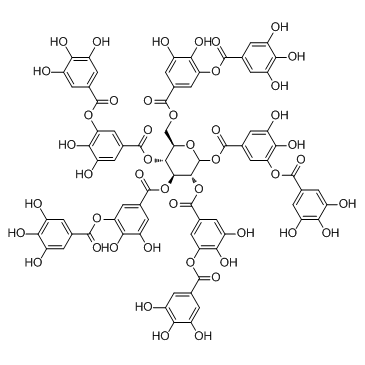1401-55-4
| Name | tannic acid |
|---|---|
| Synonyms |
Tannic acid
Gallotannin,Tannin MFCD00066397 EINECS 215-753-2 Gallotannin Tannin Glycerite |
| Description | Tannic acid is a novel hERG channel blocker with IC50 of 3.4 μM. |
|---|---|
| Related Catalog | |
| Target |
IC50: 3.4 μM (hERG channel)[1] |
| In Vivo | During the course of treatment, tannic acid significantly ameliorates these phenotypes in AD skin lesions. Tannic acid treatment aslo reduces these dermal changes compare with AD mice. Treatment with tannic acid increases PPARγ expression in AD skin sections. The PPARγ protein expression is suppressed in vehicle-treated AD mice, but when treats with tannic acid, its expression is increased dramatically. The IL-1β, TNFα, TNFR1, and COX2 protein expressions are significantly up-regulated in vehicle-treated AD mice, but significantly suppressed by tannic acid treatment[2]. |
| Animal Admin | Specific pathogen-free female 6 weeks old mice are used. The animals are maintained in a controlled room (temperature 23±2 °C, humidity 55±15%, 12 h light cycle). After 1 week, the mice arer andomly divided into 3 groups, untreated group-receive vehicle (distill water) (Normal, n=5); DfE cream treated mice (100 mg/mouse) is divided into two groups and each receives vehicle (distill water) (AD, n=5) or Tannic acid (80 mg/kg/day, per oral) (AD+Tannic acid, n=5) and are allowed free access to drinking water and standard laboratory diet[2]. |
| References |
| Density | 2.1±0.1 g/cm3 |
|---|---|
| Melting Point | 218 °C(lit.) |
| Molecular Formula | C76H52O46 |
| Molecular Weight | 1701.198 |
| Flash Point | 198°C |
| Exact Mass | 1700.172974 |
| PSA | 777.98000 |
| LogP | 13.33 |
| Index of Refraction | 1.927 |
| Stability | Stable. Incompatible with metallic salts, strong oxidizing agents, iron and other heavy metals. |
| Water Solubility | 250 g/L (20 ºC) |
CHEMICAL IDENTIFICATION
HEALTH HAZARD DATAACUTE TOXICITY DATA
|
| Hazard Statements | H412 |
|---|---|
| Precautionary Statements | P273 |
| Personal Protective Equipment | Eyeshields;Gloves;type N95 (US);type P1 (EN143) respirator filter |
| Hazard Codes | Xi: Irritant; |
| Risk Phrases | R40 |
| Safety Phrases | 24/25-36-26-36/37/39-22 |
| RIDADR | NONH for all modes of transport |
| WGK Germany | 2 |
| RTECS | WW5075000 |
| HS Code | 3201909000 |
| HS Code | 3201909000 |
|---|

